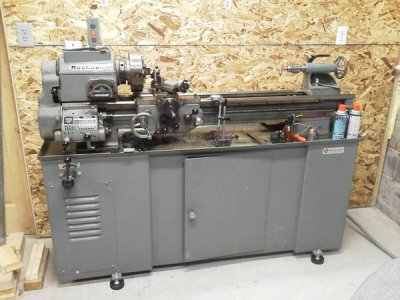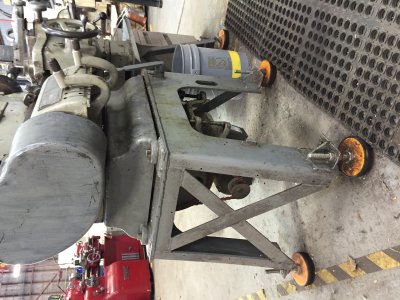-
Welcome back Guest! Did you know you can mentor other members here at H-M? If not, please check out our Relaunch of Hobby Machinist Mentoring Program!
You are using an out of date browser. It may not display this or other websites correctly.
You should upgrade or use an alternative browser.
You should upgrade or use an alternative browser.
Cabinet Setup...shims And Bolt Or Adjustable Feet?
- Thread starter 100LL
- Start date
When I leveled my 11" I got it level front to back and side to side while maintaining even weight on the feet. Level placed on the ways.
To rid any twist I put the level on the carriage and traversed back and forth. My lathe has adjustable screws/jacks at each corner allowing fine adjustment.
To rid any twist I put the level on the carriage and traversed back and forth. My lathe has adjustable screws/jacks at each corner allowing fine adjustment.
I used hockey pucks for the pads/feet. I believe it was 1/2-13 hex bolts that pass through the holes. If I did it again I would enlarge the holes to 5/8 and use a fine thread.
You can see in the pic that I made alum washers slightly smaller than the diameter of the pucks. ((I just realized this is an old pic w/o the big washer...oh well you get the idea)) This spreads the weight out and creates a more rigid pad. Nut and washer above and below tab allowing for leveling and locking in place.

You can see in the pic that I made alum washers slightly smaller than the diameter of the pucks. ((I just realized this is an old pic w/o the big washer...oh well you get the idea)) This spreads the weight out and creates a more rigid pad. Nut and washer above and below tab allowing for leveling and locking in place.

- Joined
- Dec 25, 2011
- Messages
- 10,511
Yes. If the cabinet isn't level front to back at both ends, you are twisting the cabinet, which will twist the bed. The right end can be lower by say 1/8" to facilitate coolant drainage. You would compensate by starting with 1/8" shims under the tailstock end. SOP for leveling a lathe is to level the cabinet to carpenter level accuracy. Then level the bed to machinist level accuracy.
Actually, a lathe bed does not have to be level in order to work satisfactorily. Else you could never run a lathe successfully aboard ship. The four corners just have to be in the same plane. But the machinist level is by far the cheapest way of achieving that.
Actually, a lathe bed does not have to be level in order to work satisfactorily. Else you could never run a lathe successfully aboard ship. The four corners just have to be in the same plane. But the machinist level is by far the cheapest way of achieving that.
- Joined
- Oct 7, 2013
- Messages
- 305
When I got ready to set up my DR11, I put adjustable feet on the cabinet. The bolts were 1/2-13 thread on solid steel feet, not rubber, because I wanted to minimize any movement or settling that eventually occurs with rubber. I didn't want to bolt down the lathe, because I knew I would be moving soon. As it turned out, the feet raised the lathe about 2" and made it rather tall for me to comfortably work with, besides the fact that I felt like it made the lathe less steady (the cabinet is rather narrow to begin with) and more prone to vibration. In the end I removed the adjustable feet and set the cabinet on the concrete. I would have shimmed and bolted it in my new location, but ended up selling it before I got the chance (miss that lathe). There really is no need to level the cabinet more accurately than with just a carpenter level, since the DR11 has leveling feet on the lathe bed. Bolt the cabinet down and shim it so it is roughly level and does not rock, then use the machinist level to level the lathe bed using the leveling bolts on the bed. Doing that will make the machine much more solid-feeling and minimize vibration that comes from the Reeve's drive system. Just my opinion, based on my experience with the same decision you are making.


